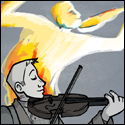|
koreban posted:This here is exactly why no one will ever be pleased with any ruleset that gets released, ever. It didn't seem to affect you, either.
|
|
|
|

|
| # ? May 30, 2024 02:49 |
|
koreban posted:How is that not a better option than "I shoot my bow, I miss. next!" Cleric: 5% chance of being TK'd for playing their melee class The risk of a TK is a fun mechanic for the ranger and a gently caress you to the cleric. That's probably why people don't like it. I like friendly fire for comedic or dramatic effect only.
|
|
|
|
koreban posted:Alternatively: Make encounters bigger than 4 on 1 and give people choices. If the choices are binary, you're probably doing something wrong. Also, you're playing into the odds if you choose to do the shooting into melee thing. You are correct: the chance of hitting the Cleric (or rather, anybody with AC 20 in those circumstances) is 3,75%. Per individual attack, by the way. Over the course of an entire combat it becomes quite unlikely for a ranged character to not harm their own, but that is such a complex issue depending on so many variables that it cannot be expressed in a single number. But that is not the point. It's not about how likely it is to hit one specific PC in one specific scenario. It's about the idea that ranged attackers become a risk to their own party, whereas the reverse is not true. Which means that melee-oriented characters can now either be a cock-block to their ranged peers (which was never the intent of the game's design) or that the melee-characters eat more damage than their hit points and healing were meant to remedy (which was never the intent of the game's design). It's a choice, yes, but the consequence is someone else's to bear. It's like playing Russian Roulette with somebody else's skull on the line. Yeah, sure, it poses an interesting choice to you... fat lot of good that does the guy whose brains just got ventilated. Now, this rule also goes for the NPCs of course. But so what? Nobody cares if Orc 3 happened to kill Orc 7 in the middle of a fight. But when the Ranger kills the Rogue, yeah, that's when all of a sudden the difference becomes clear. This rule does not impact everybody equally, and the DM has an infinite amount of orcs to draw upon.
|
|
|
|
Pleads posted:Ranger: 5% chance of TKing a friendly for making the decision Yeah friendly fire as a story point is actually a handy way to go about it, I'll use the FFG star wars system as my example (cause i always do it lol) where the only way to hit someone in melee is with the GM spending a despair (read as critical failure) but the important point is that despair cant actually be generated when shooting at normal enemies, its something either the GM has to specifically spend points to have a chance of critical failure or the player is shooting at an important villain, be it a leader/officer character or named villain. Then and only then is there an actual chance for a despair being generated. The result is that you only have dramatic friendly fire incidents when you have the melee character in a big dramatic duel with some major villain and another player decides to shoot into it which frankly is the only time where a ranged character should probably be discouraged from shooting into it. I kinda have no idea how to replicate an effect like this in D&D 5e to be honest and its veering away from the actual point. kingcom fucked around with this message at 02:26 on Dec 2, 2016 |
|
|
|
Personally I think this suggested house rule is bad because it's over complicated and would slow down play immensely. It would be too fiddly for my home game of Pathfinder!
|
|
|
|
Arivia posted:Personally I think this suggested house rule is bad because it's over complicated and would slow down play immensely. It would be too fiddly for my home game of Pathfinder! I mean I complain about pathfinder near constantly but just having it be a penalty to hit which literally anyone playing an archer type picking up a feat remove it is basically the correct way of handling this (especially given how kicken rad archers end up as in pathfinder after the finish their archer feat chain).
|
|
|
|
This is probably going to come off as namby-pamby narrative play, but sometimes I do give my players choices like, "if you fire this spell in this situation, there is a chance this will happen", but it's never an 'always on' kind of rule. It's based on the circumstances and based on what I think would be interesting, sort of like the occasional wildcard scenario in FTL or something. It's not 'every time you fire down a hallway' but it might be trying to fire an arrow over a friend's shoulder in a narrow corridor, or trying to shoot a dragon's eye while the fighter is doing something equally heroic, like trying to climb up the dragon. I tend to only do this when there is an equally attractive 'other' option besides 'don't attack' since I recognize 'don't attack' is like the worst and most boring possible outcome. I don't use a formula for these situations and tend to wing them on the fly. My players enjoy those kinds of permutations, and it's not limited to just DnD; but I think it would drive some people crazy because they'd look at my scenario and say, "this didn't happen last time, this is exactly like last time, why does this extra risk exist?" and all I can do is shrug and say, "I thought this was more interesting, sorry." Granted, I tend to make players choose between two equally good outcomes rather than two equally lovely options but I've certainly gone down that road before.
|
|
|
|
You'd still need a grid or a non-handwavey ToTM setup, but what about this as an alternative? You can't fire through non-adjacent allies. Spells, arrows, whatever, you can't hit a target if your shot would pass "through" an area occupied by friendlies. Because you'd probably hit them if you tried, and you're not an idiot. You can fire through an area occupied by enemies, but there's some chance you have to target a random enemy in the line of fire instead of your intended target. Because you're looking to do damage, not bounce arrows off the armour of someone who moves in front of your shot. You can always choose not to fire if for whatever reason you specifically don't want to shoot Orc #4. Now you've got good choices as the ranged dude: You can move to flank, but that limits your targets to those on that flank, exposes you to return fire, and makes it awkward for an ally to help you if necessary. You can move up to just behind your own front rank and fire over their shoulders, but that limits your targets to the opponent's front ranks unless you get lucky, and it definitely puts you in harms way. You can stay right where you are and pick off enemy ranged-attackers who try to flank to get a shot, but that limits your targets to those enemies. You can try to find high ground and shoot down onto whatever target you like because you won't have line-of-effect issues from up there (ie, you won't be shooting "through" an ally if for example you're shooting down at a 60 degree angle onto the opponent's front line). Elector_Nerdlingen fucked around with this message at 03:27 on Dec 2, 2016 |
|
|
|
Sage Genesis posted:But that is not the point. It's not about how likely it is to hit one specific PC in one specific scenario. It's about the idea that ranged attackers become a risk to their own party, whereas the reverse is not true. Which means that melee-oriented characters can now either be a cock-block to their ranged peers (which was never the intent of the game's design) or that the melee-characters eat more damage than their hit points and healing were meant to remedy (which was never the intent of the game's design). It's a choice, yes, but the consequence is someone else's to bear. It's like playing Russian Roulette with somebody else's skull on the line. Yeah, sure, it poses an interesting choice to you... fat lot of good that does the guy whose brains just got ventilated. In a vaccuum, you're absolutely right. I wouldn't throw this idea out during an Adventure League type game. In a homegame with people who are all friends/coworkers thought? Social pressure is definitely a thing and sometimes exploiting those relationships can be part of the fun. I believed, and still do, that it gives the melee-oriented characters a purpose. Go hunt down the big bad things, or the things with the really dangerous effects, and let the ranged attackers pick up the minions. Keep the big nasties occupied with you so they aren't blasting the squishy guys. It makes the melee character more than the doorway blocker and I've gotten very positive feedback to that end from the people in the game. Even when the Hobgoblin warlord got his extra 4d6 attack because of proximity, the paladin had to choose to kill the minion first, then focus on the warlord when they were one-on-one. quote:Now, this rule also goes for the NPCs of course. But so what? Nobody cares if Orc 3 happened to kill Orc 7 in the middle of a fight. But when the Ranger kills the Rogue, yeah, that's when all of a sudden the difference becomes clear. This rule does not impact everybody equally, and the DM has an infinite amount of orcs to draw upon. It tends to happen more often with NPCs though, and generally they're easier to hit than PCs, so when Orc3 offs Orc7, it happens "naturally" because the dice dictated it instead of from DM fiat because I overbalanced the encounter. You're right though, and the game where that happened to a PC was super tense. The net effect since then is a ton of dirty looks the ranger's way when he goes to shoot at the Paladin's targets. For the record, when I have them fighting large single targets, I don't mess with the shooting into melee poo poo. That happens when they're fighting humanoid or smaller creatures. There's no missing the dragon and hitting your paladin stuff going on. Arivia posted:Personally I think this suggested house rule is bad because it's over complicated and would slow down play immensely. It would be too fiddly for my home game of Pathfinder! This is the best criticism because it absolutely does add to the mechanics of resolving that one attack and adding time overall. I don't find that it adds a ton of extra time, though, because ~15% chance of happening~ but it does add memorable moments when it goes really right or really wrong. When the 5th ed alternative is "I miss my attack, next!" I think that's rather boring. Sage Genesis posted:Most people here are very familiar with your "houserule" - like I said, it used to be a standard D&D rule. For nearly two and a half decades, I think. (But don't quote me on that.) That's not kneejerk, that's just experience. Yeah, you're absolutely right there and I really wasn't expecting the level of visceral opposition responses that were coming in about it. I'm not familiar with older D&D rulesets that included things like friendly fire. I houseruled it in because a bunch of our early encounters were lots and lots of "I miss, next!" and that was boring. I'm used to thinking of encounters in terms of tabletop miniature games and I like the idea that everyone has something to contribute that isn't their holy trinity MMO role. As such, I break encounters down (very, very generally) into Leader/Front Line/Back Line/Support type roles. My players don't fight 15 orcs all at once. They fight a warlord, and 6 orcs, with 6 more shooting bows from behind, 3 on wolves and a magicky shaman type throwing down weird spells or heals from behind the lines. Ignoring any of those groups would be deadly to the group and instead of running the paladin and cleric into melee while the warlock Eldrich Blasts and the ranger horde breakers for the next 10 turns, there's a hundred other spells and abilities they can throw down to try and deal with the encounter. And if the ranger decides to focus fire, then it's a 3.75% chance to trigger me penalizing the party for 5th ed's bad rules. AlphaDog posted:You'd still need a grid or a non-handwavey ToTM setup, but what about this as an alternative? If we ran grid, that's probably what I would do.
|
|
|
|
koreban posted:If we ran grid, that's probably what I would do. You can still ToTM it, just tag the ranged character "up the back", "flanked right", "flanked left" and "adjacent melee" and wing it from there.
|
|
|
|
I'll think about it for a later encounter.. The next couple they're coming across are going to be fairly straightforward at a forest clearing, and then in a copy of said clearing in the feywild.. Like I mentioned earlier, the group has been positive on the idea and the couple of times that it went against the party's interests made for memorable encounters and earned "TK" his nickname at the VA hospital.
|
|
|
|
koreban posted:I'll think about it for a later encounter.. The next couple they're coming across are going to be fairly straightforward at a forest clearing, and then in a copy of said clearing in the feywild.. Like I mentioned earlier, the group has been positive on the idea and the couple of times that it went against the party's interests made for memorable encounters and earned "TK" his nickname at the VA hospital. Then I think the comment earlier is the best one, if its working for your group and has caused zero problems, then you have no reason to think about this until you run it for a different group. koreban posted:Yeah, you're absolutely right there and I really wasn't expecting the level of visceral opposition responses that were coming in about it. I'm not familiar with older D&D rulesets that included things like friendly fire. I houseruled it in because a bunch of our early encounters were lots and lots of "I miss, next!" and that was boring. I'm used to thinking of encounters in terms of tabletop miniature games and I like the idea that everyone has something to contribute that isn't their holy trinity MMO role. Though given what you said earlier, I would maybe recommend having a read over the 4e rulebooks if you are looking for a bit more of a tactical game. I feel like it would hit all your benchmarks.
|
|
|
|
I think the ranger having a chance to hit if he fires into melee is fine so long as it works both ways. The Paladin worships Kord and so occasionally when she misses a melee attack, Kord will smite that cowardly ranger for not having the guts to get into the melee. And when the barbarian misses, sometimes her axe goes flying out of her hands, right at the ranger for some weird reason (it's Kord, having a laugh). But seriously, all this stuff is missing the point. D&D is fun combat with powers and Aitch Pees, not realistic. If you want a system that has that sort of realism about shooting into a melee, you have to think through how this sort of thing should work. Why have anyone go into melee at all if it's just a downside to the team to do so? Why would anyone have done it in real life? Well, in real life when you are trying to reload your crossbow and a dude with an axe closes with you, you just surrender because you are basically turbofucked if you don't. So there, now we have a legit house rule to match the shooting in melee one: when a melee character closes with a ranged-weapon using enemy, they can take them out of the fight with one hit (they still have to roll to hit). Now you have some genuinely interesting interactions and having an effective front line is actually important instead of pointless. You probably have to beef up opportunity attacks or something to make it so you can't just run straight for the ranger, but the basic idea is sound. And I know that this can work if you make the right adjustments because it works in XCOM when chryssalids and berserkers try to gently caress up your poo poo.
|
|
|
|
So I'm going to be playing in a fun and cheerful game of Curse of Strahd coming up and I would like to play a nun who discovers the power to kill the undead with the radiant power of her walking stick, i.e., a Paladin/Undying Light Warlock multiclass, the goal being to use some combination of a quarterstaff, Polearm Master, maybe Green Flame Blade (or maybe Shillelagh with Pact of the Tome?), and Radiant Soul, to ultimately deal 1d8+CHA/1d4+CHA damage on an attack, or I don't even know how much stupid radiant damage on a Green Flame Blade hit. Is this a mechanically sound idea? How would you go about setting it up? I'm thinking Paladin 1 for proficiencies, Warlock 1 for radiant soul and green flame blade, Paladin 2 for spells and smiting, and then go Warlock until Pact of the Tome.
|
|
|
|
Quorum posted:So I'm going to be playing in a fun and cheerful game of Curse of Strahd coming up and I would like to play a nun who discovers the power to kill the undead with the radiant power of her walking stick, i.e., a Paladin/Undying Light Warlock multiclass, the goal being to use some combination of a quarterstaff, Polearm Master, maybe Green Flame Blade (or maybe Shillelagh with Pact of the Tome?), and Radiant Soul, to ultimately deal 1d8+CHA/1d4+CHA damage on an attack, or I don't even know how much stupid radiant damage on a Green Flame Blade hit. Is this a mechanically sound idea? How would you go about setting it up? I'm thinking Paladin 1 for proficiencies, Warlock 1 for radiant soul and green flame blade, Paladin 2 for spells and smiting, and then go Warlock until Pact of the Tome. Not sure how you'd get shillelagh with paladin and warlock, but you can do it if you play a nature cleric, but that may not matter because as a paladin you can take a longsword for the 1d8 base damage and you get Magic Weapon at 5th level when you unlock 2nd level spells.
|
|
|
koreban posted:Not sure how you'd get shillelagh with paladin and warlock, but you can do it if you play a nature cleric, but that may not matter because as a paladin you can take a longsword for the 1d8 base damage and you get Magic Weapon at 5th level when you unlock 2nd level spells. Pact of the Tome lets you choose cantrips from other classes.
|
|
|
|
|
Yeah, I can always do a longsword, the nice thing about quarterstaves is the extra 1d4(+attack modifier I think?) damage attack you can tack on with Polearm Master, which stacks beautifully with the 1d4+cha radiant damage you add to all weapon attack damage with Divine Favor and Radiant Soul. Now, if I got a Sunsword on the other hand...
|
|
|
|
Wanting people to separate themselves into various roles is cool and good, but they actually need to have the kinds of tools to perform those roles. I mean, obviously a Cleric can be a "healer" because they have healing spells, but designating a Fighter as "hallway blocker" only works if: 1. They can physically completely block the hallway all by themselves. 2. Or they have powers and abilities that make them either dangerous to ignore, or difficult to move past 3. Both Now, in older D&D rulesets, #1 applied, because most dungeons were composed to 1-square-wide corridors, and characters were treated as occupying the entire 10-foot width of the corridor. If your Fighter was in front, the orcs literally could not get to the Magic-User in the back until the Fighter was dead (or otherwise physically removed) In more recent D&D rulesets, you had things like fleshed out Opportunity Attack rules, Stances to allow you to OA even if the enemy takes a 5-foot-step (which normally does not draw OA's), and Stances that cause enemies who are NOT attacking the Fighter to take penalties. Because corridors were wider, rooms were larger, and you needed the Fighter to be able to present themselves as a credible threat and an active blocker if they were to be able to perform their role. Rules and mechanics matter. Well-crafted rules and mechanics matter. And this is where the problem of 5e largely lies: a player can SAY that they want to "tank", but a lot of the time they can't actually do that using just the rules of the game as-is. You could homebrew up a thing. You could also say that the monsters are going to be attacking the Fighter as though the Fighter was the tank based solely on their say-so. You could even go a middle-route and give the Fighter's "attractiveness" to the monsters be based on what the player narratively says they're doing plus-or-minus how well they're rolling. But ideally, that's the sort of thing that the rulebook should give you guidelines on how to perform to begin with, without asking you to make it all up yourself. Vengarr posted:Just listening to TAZ it seemed like you could use Advantage and opposed skill checks to make melee attacking interesting without resorting to giving the warrior a bunch of abilities like World of Warcraft. Like you don't have a Cleave ability anymore, but if the warrior says "I want to take a wide swing at both goblins" you could just give him Disadvantage on hitting the second guy. Does that not work in practice? This doesn't really work in practice: 1. The odds of the second attack doing anything are low. Disadvantage is a thing you do not want to be working with. 2. More importantly, you're still not discouraging the Fighter from doing it as often as it's available In the context of things that D&D can characters can do, you either limit it by the number of times it can be done, or you can limit it by making it mutually exclusive with something else. Let them Cleave a dude so many times a day/per encounter/per Short Rest Or, let them pick between Cleaving a dude, hitting one dude more accurately, or hitting one dude harder gradenko_2000 fucked around with this message at 05:54 on Dec 2, 2016 |
|
|
|
koreban posted:Not sure how you'd get shillelagh with paladin and warlock, but you can do it if you play a nature cleric, but that may not matter because as a paladin you can take a longsword for the 1d8 base damage and you get Magic Weapon at 5th level when you unlock 2nd level spells.
|
|
|
|
Friendly fire rules work better in older editions because you didn't have an expectation of narrow specialization. Switching to a sword from a bow just gave you minor penalties in comparison. OTOH in 3.x and after - where "building a character" is what you do and where narrow specialization is the norm, it becomes more punitive.
|
|
|
|
gradenko_2000 posted:In the context of things that D&D can characters can do, you either limit it by the number of times it can be done, or you can limit it by making it mutually exclusive with something else. All fighter weapons become 2dX. Roll to hit. The weapon damage dice may be applied to the original target, or to adjacent enemies, as you see fit. Your extra (nonweapon) damage only applies to the original target. You can spend a fightin' point (combat die, whatever) to add extra weapon damage dice to your cleave (eg: if your sword is 2d4, one point = +1d4).
|
|
|
|
AlphaDog posted:All fighter weapons become 2dX. Isn't that just the Battlemaster's superiority dice/sweeping attack mechanic?
|
|
|
|
The Battlemaster's schtick works as far as having a limited resource, but it doesn't cover the "always-on, but mutually exclusive decision" part. That is to say, a Wizard can select from spells to spend their different spell slots on, but even after they run out of those, they can still choose between Acid Splash (30 foot range, 1d6 damage, hits two creatures), Fire Bolt (120 foot range, 1d10 damage) or Ray of Frost (60 foot range, 1d8 damage, slows target). It's not like the Wizard has to roll Disadvantage on their Acid Splash's ability to hit a second target.
|
|
|
|
Right, but his proposed solution is basically the battlemaster's superiority dice schtick. If you want to simplify it further, use the Rogue's sneak attack table as a baseline analogue. Add Xd6 damage to a successful basic attack action or spend the bonus damage to roll to hit Xd6 additional hostile creatures that you can see and are in your melee range. Everyone will be polearm masters afterwards, but whatevs. Maybe have a defensive one where you can add Xd6 to your AC for a turn or spend them for a reaction to confer disadvantage to an attack against an ally from a creature you're in melee with. E: yeah, it's basically the same idea he's proposing, I'm just tying it to an existing table analogue in the pub and expanding on options.
|
|
|
|
Not really like the battlemaster. The idea is that there's a baseline always available part that offers an attack choice each round, then on top of that there's a resource-limited part to make the attack better. It's two things interacting. A simple round-by-round tactical choice (attack hard / attack wide), and a simple strategic choice (spend to win faster now / conserve to win faster later). I don't understand the polearm master comment. With what I wrote, baseline is you can hit either one, two, or three opponents, and the second and third target have to be adjacent to you. Spending resources lets you hit +<points spent> opponents and doesn't lift the adjacent requirement. Elector_Nerdlingen fucked around with this message at 11:26 on Dec 2, 2016 |
|
|
|
I was thinking maybe "roll attack, if you succeed, roll for additional effect". Like if you want to target the legs, you have to hit (and thus roll damage), and then succeed on another more difficult attack roll for the bonus effect, being slowed or knocked prone or whatever. Or maybe the monster has to make a saving throw, like if you bash it in the face with your pommel it has to save vs. Fortitude or something or be dazed for a round. Of course, the warrior would try something like that every round. The alternative is maybe some kind of Adrenaline resource? Warriors get three points or something at the start of every fight, and can use a point to add bonus effects to a successful attack. Rogues and back-line fighters get 2, Non-dedicated fighters like clerics can get 1. It does look like I'm gonna be stuck with D&D 5E for my game, so I'm committed to trying to make it work. Or at the very least, "Broken but fun". Vengarr fucked around with this message at 17:20 on Dec 2, 2016 |
|
|
|
Vengarr posted:The alternative is maybe some kind of Adrenaline resource? Warriors get three points or something at the start of every fight, and can use a point to add bonus effects to a successful attack. Rogues and back-line fighters get 2, Non-dedicated fighters like clerics can get 1. Yes. Even something as simple as "spend a point to add a +2 to +5 to an attack" would be a significant increase in "interactivity" and "meaningful decisions"
|
|
|
|
Vengarr posted:It does look like I'm gonna be stuck with D&D 5E for my game, so I'm committed to trying to make it work.
|
|
|
|
I'm specifically being asked to DM a game of D&D, so I don't think that will fly.
|
|
|
|
gradenko_2000 posted:The Battlemaster's schtick works as far as having a limited resource, but it doesn't cover the "always-on, but mutually exclusive decision" part. see this is why wizards should be reflavored into fighters. choose between cleave attack (10 ft range, d10+str+prof damage , hits as many( enemies as can be reached), bow attack (120 ft, d10) or strong attack (2d8 + str+prof)
|
|
|
|
Vengarr posted:I'm specifically being asked to DM a game of D&D, so I don't think that will fly. You don't necessarily have to say yes. 
|
|
|
|
Vengarr posted:I'm specifically being asked to DM a game of D&D, so I don't think that will fly.
|
|
|
|
Vengarr posted:I was thinking maybe "roll attack, if you succeed, roll for additional effect". Like if you want to target the legs, you have to hit (and thus roll damage), and then succeed on another more difficult attack roll for the bonus effect, being slowed or knocked prone or whatever. Or maybe the monster has to make a saving throw, like if you bash it in the face with your pommel it has to save vs. Fortitude or something or be dazed for a round. Of course, the warrior would try something like that every round. Do damage if you hit AC, do damage and effect if you hit AC+X. Choose an effect after you hit. Does much the same thing and uses just the one roll. Keep it simple: limit "effect" to disarm, knock prone, or push back, and set X to 4. Make it complicated: X could be higher or lower depending on the effect. Or X could be set by the monster's stat block with some monsters being easy to gently caress with and some being harder. Maximum effort: have a list of effects per monster and a number-over-AC to hit to do each of them. Telegraph which effects are available per monster when you describe it. (Don't do this though, it's less "houserule" and more "totally changing how fights will play out while also rewriting the entire monster manual"). Elector_Nerdlingen fucked around with this message at 22:05 on Dec 2, 2016 |
|
|
|
Vengarr posted:I'm specifically being asked to DM a game of D&D, so I don't think that will fly. My half-assed attempts to fix D&D basically just involve being as generous as possible with people's creative ideas. I tend to give martials more carte blanche when it comes to feats of acrobatics and athletics. We have a table rule where strong characters just accomplish strength-based stuff without rolling, and nimble characters just kind of tight-rope walk without rolls, etc. Plus I'm really liberal with magic weapons, and I try to add other properties to them so that the martials have other options besides just attacking. It's entirely possible to have fun with 5e but it does require you to pay attention to how people are feeling about their characters.
|
|
|
|
Gort posted:You don't necessarily have to say yes. The following assumes that you intend that statement as "they may say they want to play this, but if they knew what they are getting into, then they would play something else." In the case of first-timers, it is reasonable enough to want to use the most culturally-known system's most updated edition. They may end up not liking it, but now they know more fully and precisely what they want for a system in the future, which is a good thing. Perhaps they could have enjoyed something more thoroughly- likely so, given how everyone reacts a bit differently. However, forming a baseline for how they like RPGs is still good. Experienced players, on the other hand, may want to try out a particular system. Perhaps they have played Dungeon World or a very rules-light system, but want to test out something "crunchier." Perhaps they simply want to, again, see how the "classic" system plays these days. Once they try out it for themselves, thus forming an individual opinion, they can compare it to alternatives. Theory-crafting and reading up others' reviews can only get one so far. In short, it's okay to let the players decide the system. While the GM/DM position holds more responsibility and has more interaction with the system, it's okay to take that responsibility to help everyone have fun even if it's not your favorite. If your players are having fun, you'll likely have fun as well, no matter the rules. That said, if the setup requirements or other features of being the DM make you absolutely miserable, then you are justified in refusing the call. I don't want to make it a matter of self-sacrifice. ...And if your players immediately hate it, then that's when you get to swap in your preferred system. Bam, instant game group with some investment. Mendrian posted:My half-assed attempts to fix D&D basically just involve being as generous as possible with people's creative ideas. I tend to give martials more carte blanche when it comes to feats of acrobatics and athletics. We have a table rule where strong characters just accomplish strength-based stuff without rolling, and nimble characters just kind of tight-rope walk without rolls, etc. Plus I'm really liberal with magic weapons, and I try to add other properties to them so that the martials have other options besides just attacking. Agreed on that. Some things do need careful balance in order to make sure characters can still do feats of heroism without falling on their faces more often then not. However, if you're too generous, the issue is not that people get out of hand, but instead that there's less sense of progression. Removing the need for rolls helps for some cases, but the extremes should still have a chance to fail, especially at low levels. That way, their goals and abilities stay in sync as their epic deeds pile up. People like getting better at things, after all, even if it's just a character of the collective imagination.
|
|
|
|
Vengarr posted:I'm specifically being asked to DM a game of D&D, so I don't think that will fly. Zomborgon posted:The following assumes that you intend that statement as "they may say they want to play this, but if they knew what they are getting into, then they would play something else."
|
|
|
|
Vengarr posted:I'm specifically being asked to DM a game of D&D, so I don't think that will fly. You should be fine. 5E is so streamlined and easy to pick up, and fighting is pretty quick and painless.
|
|
|
|
I'm in basically the same boat - it will be my first time DMing to a group of new players, just picking up the newest D&D with the nice low-setup starter set seemed easiest. Gonna give that a trial run and see how we like it. The adventure certainly seems better than one in the pathfinder starter set, which was just the one dungeon. I've read way too much about all of them at this point but I think that's easiest. 4e sounds fun but fiddling with combat math myself to make encounters shorter seems like a bridge too far, curious why they didn't reprint the original MM. I'm already thinking about what to fudge, probably will only have 3 players and the starter adventure seems plenty lethal for 4 players. Really, the starter traps when my players are gonna have no clue to look for them do 2d6 damage? Making that 1d6 seems easy sensible to me. Jeffrey of YOSPOS fucked around with this message at 22:49 on Dec 2, 2016 |
|
|
|
Splicer posted:It's also reasonable to go "This is an RPG like D&D but I think it does the things you want to do a bit better" and then do the other stuff you said. Yes, that is true. Given Vengarr's tone, it seemed that that was already done and dismissed.
|
|
|
|

|
| # ? May 30, 2024 02:49 |
|
Jeffrey of YOSPOS posted:I'm already thinking about what to fudge, probably will only have 3 players and the starter adventure seems plenty lethal for 4 players. Really, the starter traps when my players are gonna have no clue to look for them do 2d6 damage? Making that 1d6 seems easy sensible to me. You can also give verbal hints about certain areas. For new players, you have to sort of prod them into what needs to be done.
|
|
|






































